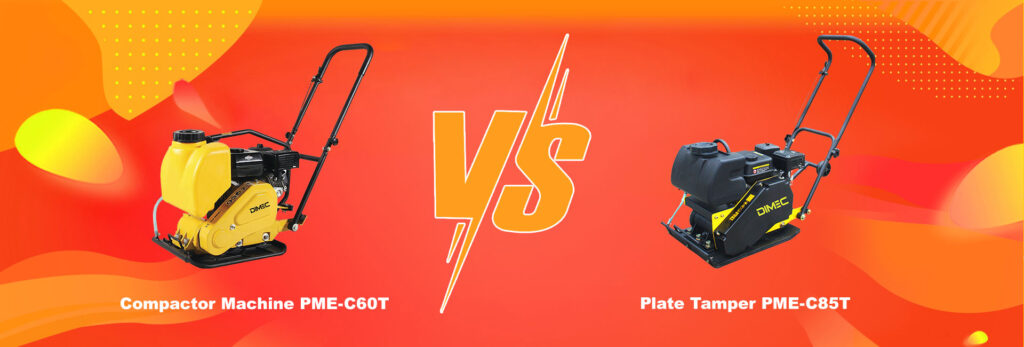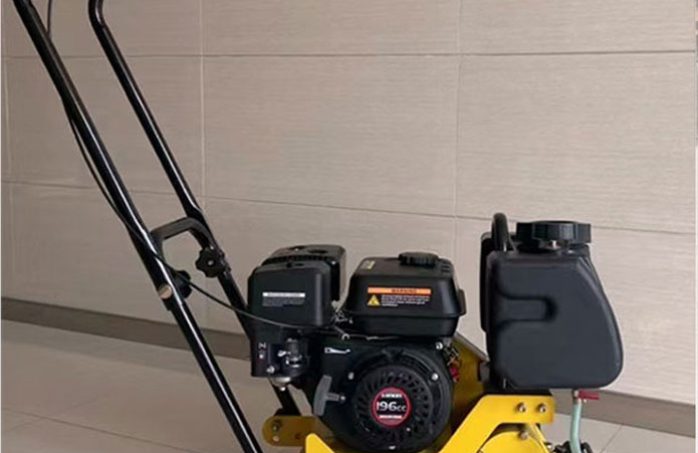Compactor Machine PME-C60T vs Plate Tamper PME-C85T: A Detailed Comparison
- DIMEC
- Компакторная машина, Plate Tamper
- 20/02/2025
Главная " Компакторная машина PME-C60T vs Plate Tamper PME-C85T: A Detailed Comparison

Оглавление
Введение
In the construction industry, selecting the right compaction equipment is crucial for ensuring efficient and effective soil compaction. The Compactor Machine PME-C60T and Plate Tamper PME-C85T are two popular models that cater to different project requirements. This article provides a comprehensive comparison of these two machines, focusing on their technical specifications, performance capabilities, and ideal applications.
Technical Specification
| Model | Compactor Machine PME-C60T |
|---|---|
| Engine | Honda / Robin / Loncin / Diesel engine |
| Engine type | Air-cooled, single cylinder, 4-stroke, petrol engine / diesel engine |
| Frequency [VPM] | 5600 |
| Centrifugal force [KN] | 12 |
| Plate size (LxW) [cm] | 50x36 |
| Max.compaction depth[cm] | 28 |
| Travel speed [m/min] | 25 |
| Max.inclination angle | 20° |
| N.W./G.W. [kg] | 68/73 |
| Package (LxWxH) [cm] | 75x38x61 |
| Model | Plate Tamper PME-C85T |
|---|---|
| Engine | Honda / Robin / Loncin / Diesel engine |
| Engine type | Air-cooled, single cylinder, 4-stroke, petrol engine / diesel engine |
| Frequency [VPM] | 4200 |
| Centrifugal force [KN] | 14 |
| Plate size (LxW) [cm] | 59x43 |
| Max.compaction depth[cm] | 30 |
| Travel speed [m/min] | 25 |
| Max.inclination angle | 20° |
| N.W./G.W. [kg] | 86/91 |
| Package (LxWxH) [cm] | 75x45x58 |
Сравнение производительности
Engine Power and Efficiency
Both machines are powered by a 5.5 HP engine, providing sufficient power for demanding compaction tasks. However, the PME-C85T’s larger plate size and higher compaction force make it more suitable for large-scale projects.
Plate Size and Compaction Force
The PME-C60T has a 50 x 36 cm plate, generating a compaction force of 12 KN/sq.ft, while the PME-C85T features a larger 64 x 42 cm plate, delivering a more significant compaction force of 15 KN/sq.ft. This makes the PME-C85T ideal for projects requiring deep and uniform compaction.
Operational Speed and Coverage
The PME-C60T operates at a higher vibration frequency of 5600 VPM, allowing for faster compaction over smaller areas. In contrast, the PME-C85T, with a vibration frequency of 4200 VPM, covers larger areas more efficiently due to its larger plate size.
Applications and Ideal Projects
Compactor Machine PME-C60T
- Urban Road Repairs: Excellent for dust control and avoiding work stoppages near sensitive zones.
- Desert Solar Farms: The water tank enables compaction of dry sand without external water trucks.
- Mining Access Roads: Controls silica dust and navigates temporary haul roads effectively.
Plate Tamper PME-C85T
- Large-Scale Road Construction: Ideal for achieving deep compaction depths required for highway subgrades.
- Industrial Foundations: Suitable for heavy-duty compaction tasks in industrial settings.
- Commercial Paving: Provides high compaction force and speed, making it perfect for extensive paving projects.
Operational Considerations
Ease of Use and Ergonomics
Both machines incorporate advanced low-vibration technology and ergonomic controls to ensure operator comfort during prolonged use. The PME-C60T’s compact design makes it easier to maneuver in tight spaces, while the PME-C85T’s larger size is better suited for open areas.
Maintenance and Durability
Regular maintenance is essential for both machines to ensure peak performance. The PME-C60T has a relatively simple design, making maintenance tasks straightforward. The PME-C85T, with its more complex components, requires more frequent checks but is built to endure heavy-duty use.
Cost-Effectiveness and ROI
The PME-C60T offers excellent value for small to medium-sized projects, providing reliable performance without excessive power costs. The PME-C85T, although more expensive initially, offers significant long-term savings by reducing labor costs and project timelines in large-scale projects.
Заключение
Choosing between the Compactor Machine PME-C60T and Plate Tamper PME-C85T depends on your project’s specific requirements. If you need a machine for dust control, urban projects, or small-scale tasks, the PME-C60T is the better choice. For large-scale, heavy-duty projects requiring deep compaction, the PME-C85T is the clear winner.
By understanding the differences in engine performance, plate size, operational speed, and application suitability, you can confidently select the machine that will ensure the success of your construction project.
Вопросы и ответы
Q1: What is the main difference between the PME-C60T and the PME-C85T?
The main difference lies in their plate size and compaction force. The PME-C60T has a smaller plate and lower compaction force, making it suitable for smaller projects, while the PME-C85T has a larger plate and higher compaction force, ideal for large-scale projects.
Q2: Which machine is better for confined spaces?
The PME-C60T is better suited for confined spaces due to its smaller size and lighter weight, making it easier to maneuver in tight areas.
Q3: How do the engine powers compare between these models?
Both machines are powered by a 5.5 HP engine, but the PME-C85T’s larger plate size and higher compaction force make it more suitable for demanding tasks.
Q4: What types of projects benefit most from the PME-C85T?
Large-scale road construction, commercial paving, and high-traffic area development projects benefit most from the PME-C85T due to its deep compaction capabilities and high compaction force.
Q5: How do both machines ensure operator comfort during prolonged use?
Both machines incorporate advanced low-vibration technology and ergonomic controls to minimize operator fatigue and ensure comfort during extended use.
Feel free to contact us for any questions and doubts.
Plate Compactor X Tamping Rammer X Road Roller
Не стесняйтесь обращаться к нам по любым вопросам и сомнениям
Вам также может понравиться
What are the Advantages of Using a Trench Rammer Over Other Compaction Equipment?
Table of Contents Introduction When it comes to construction, one crucial aspect is ensuring that the soil is compacted properly. This is where compaction equipment comes into play, and among the various tools available, trench rammers stand out. But why should you consider using a trench rammer over other types of compaction equipment? Let’s dive into the myriad advantages that trench rammers offer. What is a Trench Rammer? A trench rammer, also known as a jumping jack tamper or tamping rammer, is a type of compaction equipment designed specifically for compacting soil in confined spaces such as trenches. It features a narrow, upright design and utilizes a high-impact force to compact the soil efficiently. Key components of a trench rammer include the ...
Читать дальше →
Introduction to Walk Behind Roller Compactor
Table of Contents A Walk Behind Roller Compactor is an essential piece of equipment used in construction and landscaping, primarily designed for compacting soil, gravel, and asphalt. Whether you’re working on a road construction project or a new landscape design, a walk-behind roller compactor can help improve the density and stability of your surface, ensuring it remains durable for years. Definition of a Walk Behind Roller Compactor A Walk Behind Roller Compactor is a type of small, single-operator roller machine with either a single drum or dual drums. It is primarily used for compacting materials such as soil, gravel, and asphalt. Unlike larger ride-on compactors, the walk-behind version allows for more precision in smaller or more confined spaces, making it ...
Читать дальше →
All You Need to Know About Diesel Jumping Jacks
Table of Contents What is a Diesel Jumping Jack? A diesel jumping jack, often called a “tamping rammer” or “rammer compactor,” is a heavy-duty machine designed to compact soil, gravel, or asphalt in construction projects. Think of it as the gym buddy of the construction world—it delivers powerful, repetitive blows to flatten surfaces efficiently. Definition and Basic Functionality Unlike manual tamping tools, a diesel jumping jack uses a combustion engine to drive a piston that slams a heavy plate onto the ground. This repeated impact compresses loose materials, creating a stable base for foundations, roads, or pavements. Key Components of a Diesel Jumping Jack Diesel Engine: The powerhouse that fuels the machine. Impact Plate: The metal base that makes contact ...
Читать дальше →
7 Key Features to Look for When Choosing a Jaw Crusher
Table of Contents In the world of mineral processing and aggregate production, jaw crushers play a vital role. These robust machines are designed to crush and break down large rocks, ores, and other materials into smaller, manageable pieces. Whether you’re in the mining, quarrying, or construction industry, selecting the right jaw crusher can significantly impact your operational efficiency and productivity. At first glance, jaw crushers may seem like straightforward pieces of equipment. However, numerous factors contribute to their performance, durability, and overall cost-effectiveness. To ensure you make an informed decision, we’ve compiled a comprehensive list of seven key features to consider when choosing a jaw crusher. Robust Construction One of the most critical aspects of a jaw crusher is its ...
Читать дальше →
10 Common Mistakes When Using a Concrete Mixer
Table of Contents Introduction: Understanding the Common Mistakes in Concrete Mixing When it comes to using a concrete mixer, mistakes can have serious implications on the outcome of your project. Whether you’re working on a large-scale construction site or a small DIY project, knowing what pitfalls to avoid can help you achieve a durable and high-quality concrete mix. This article will guide you through the 10 most common mistakes made when using a concrete mixer and how to prevent them. By understanding these errors, you can save time, money, and effort while ensuring that your concrete is mixed perfectly every time. 1. Not Properly Setting Up the Concrete Mixer One of the first mistakes many people make is not properly ...
Читать дальше →
Plate Compactor PME‑C50 vs Tamping Rammer PME‑RM32: A Detailed Comparison
Table of Contents When it comes to construction and landscaping projects, choosing the right compaction equipment is crucial. In this article, we’ll compare the Plate Compactor PME-C50 and the Tamping Rammer PME-RM32, two powerful machines designed to meet different soil compaction needs. Technical Specification Plate Compactor PME-C50 Model Plate Compactor PME-C50 Engine Loncin LC152F Engine type Air-cooled, single cylinder, 4-stroke, petrol engine / diesel engine Frequency [VPM] 5200 Centrifugal force [KN] 9 Plate size (LxW) [cm] 43×31 Max.compaction depth[cm] 20 Travel speed [m/min] 20 Max.inclination angle 20 N.W./G.W. [kg] 54/58 Package (LxWxH) [cm] 69x38x53 Tamping Rammer PME-RM32 Model Tamping Rammer PME-RM32 Engine Honda GX35 Engine type Air-cooled, single cylinder, 4-stroke, petrol engine Fuel tank [L] 0.7 Leap height [mm] 50 Frequency [VPM] ...
Читать дальше →
Preferred Brands of Engineering Compaction Equipment
Three Core Product Lines for Efficient Construction

Plate Compactors (40KG - 750KG)
We offer a wide range of models from light to heavy - duty. Modular design fits multiple jobs like municipal work and asphalt repair.

Tamping Rammers (32KG - 90KG)
Nine models with Honda/Robin/Loncin power. Smart fuel control and ergonomic design. Ideal for trench and slope work.

Road Rollers (0.3T - 5.5T)
Multi - level amplitude for different materials, and real - time compaction monitoring. Serve all road - building stages.

